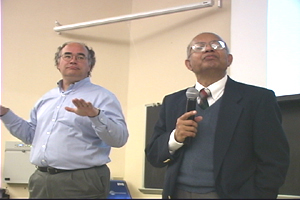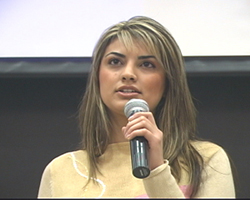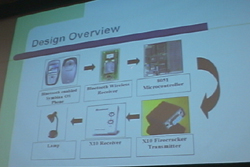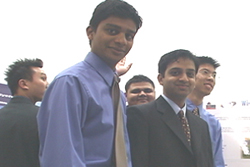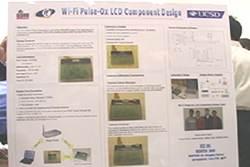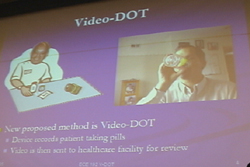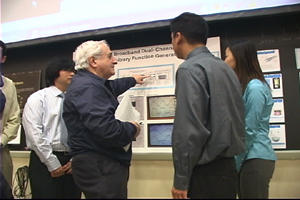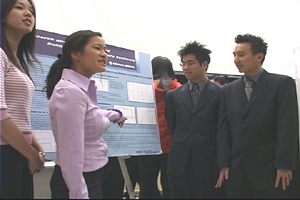UCSD Engineering Students Showcase Real-World Group Design Projects
By Doug Ramsey
|
3.31.2005 - It was the last day of the winter quarter, but the rain outside couldn't dampen the spirits of students inside the cavernous auditorium on the UCSD campus. More than 70 were there to deliver their final presentations for ECE 191. The Electrical and Computer Engineering course gives many students their first real taste of hands-on, team engineering. They are required to design, build, demonstrate and document an engineering project from start to finish for real-world 'clients,' including Calit2, other research institutions and corporations.
Calit2 underwrote five of the 18 teams this winter. Other sponsors included the Space and Naval Warfare (SPAWAR) Command and General Atomics (three teams each); UCSD School of Medicine and Scripps Institution of Oceanography (two each); and single teams were sponsored by Northrop Grumman, Holowave, and a partnership of Anokiwave and San Diego Fire & Rescue.
"We want to thank all the sponsors for the effort they've put in for our students over the quarter," said ECE professor Clark Guest, who co-taught the course with adjunct professor Pankaj Das. "They are really the instructors for this course, and we're the referees. Every one of the sponsors has taught their students a great deal." Added Das: "We are hoping that after the excellent progress made by the students this quarter, our sponsors will consider coming back again and again to sponsor and mentor more projects."
|
The five projects supported by the UCSD division of Calit2 all involved emergency-response technologies under development for ongoing homeland-security programs. Selena Salazar, Youn Woong Kim and Tanya Rostani developed a "man-down" device to detect when a first responder such as a fireman is no longer upright or on the move.
"This device is capable of detecting a sudden change in acceleration that is characteristic of a fall, or a prolonged stationary position," said Salazar. "It will then communicate this information over Bluetooth to the first responder's cell phone, which will automatically relay the information to the command and control center." The team recommended that next quarter's team work on integrating a Bluetooth module into the current system, and from there compose a working demonstration of the man-down detection device.
The group was mentored by Calit2 senior researcher Paul Blair, who also coached a second ECE 191 team that worked on a cellular system for home automation. "Our system allows us to control multiple appliances from only one device -- the cell phone," said student presenter Hooman Borghei. "No longer do you require multiple remotes for multiple appliances. We can do everything from turning on your lights to turning on your toaster, from the same cell phone you use to make calls."
|
"We used the Symbian OS data-enabled operating system to develop an interface for the cell phone, which will allow the user to choose a command that the household device will ultimately receive," said team member Ardi Baniahmad. The cell phone would interface via Bluetooth and RF with the widely used X-10 home-automation system for controlling lights, sensors and appliances. "Our project produces an affordable solution to home automation," said team member Nicholas Chung. "It also produces a solution for America's aging population and their need for independence."
Using wireless technology to assist the disabled is a passion for part-time Calit2 researcher John Miller, who mentored the ECE 191 team that worked on "Zigzag" - a computer-controlled, sense-of-touch guiding system for first responders. "In a real disaster situation, rescue workers may not be able to rely on their vision to get from point A to point B," noted student Miho Nakao. "The Zigzag sense-of-touch guidance system will allow rescue workers to reach their destination safely while completing their task."
The Zigzag group was co-sponsored by Calit2 and the NSF-funded RESCUE (Responding to Crises and Unexpected Events) project. The students constructed three different prototypes of the handheld gizmo using different input devices. The third prototype is computer-controlled and can integrate GPS-based "smart pointer" software and wireless technology to guide the rescue worker more effectively in an emergency situation. The technology has strong potential in non-emergency situations as well, notably as a tool to help the blind -- including mentor John Miller -- navigate buildings and terrain.
Calit2 and the Wireless Internet Information System for Medical Response in Disasters (WIISARD) project sponsored an engineering design team for the fourth quarter in a row. "This quarter's group of students was our best ever," said Douglas Palmer, a senior research scientist with Calit2. "This course is important outreach for the institute because it is grooming undergraduates for engineering careers while also putting them to work designing technologies that can have very tangible benefits for society."
The four-person team mentored by Palmer was charged with designing an LCD display for a Wi-Fi-enabled pulse oximeter -- a handheld device that monitors two major health factors in an emergency situation: blood oxygen and pulse rate. With support from companies including DPAC Technologies, WIISARD researchers are developing a wireless version of the device that could be use in mass casualty situations.
|
||||
The ECE 191 students designed an LCD display and presented a mock-up of the device at the event. "We are producing a medical device that monitors a patient's vital signs and transfers that data wirelessly to a command center or hospital where they can marshal appropriate medical resources," said senior Jeffrey Pon. Added team-mate Chintan Sheth: "We are looking forward to seeing our LCD implemented on the Wi-Fi pulse oximeter and seeing that its wireless capabilities are put to good use. We also hope that it will help save lives in the future."
A fifth team sponsored by Calit2 was a holdover from the previous quarter, when two of the students were so excited about their project that they asked to continue with it. Mark Noah and Robert Romabiles are putting the finishing touches on a system for tracking UCSD's campus shuttle buses via GPS-enabled cell phones. "Some of the improvements we implemented this quarter included a GPS-sending algorithm," said Noah. "This way, if the speed of the shuttle is zero, we are not going to send out the GPS position, because that means it's not moving. We are using the Verizon Wireless service and this will save on airtime."
Under the guidance of Calit2 mentor John Zhu, the students also designed and wrote a BREW application for the shuttle tracking process and are looking forward to full-scale deployment. "Next quarter we are going to design the website so students can use it," said Romabiles. "We are also trying to set up a kiosk for the campus loop so that you can see where the bus is at any given time." To do so, they plan to pitch companies in the wireless industry for sponsorship funding.
A team of students sponsored by the UCSD School of Medicine was also a holdover from the previous quarter. They are developing a system to let nurses directly observe tuberculosis patients taking their medication -- remotely. "If you don't take your medication, you can be very contagious and a public health risk, and, even worse, the disease can mutate and the drugs become useless," said student Vinit Modi. "With direct observed therapy [DOT], a nurse visits the patient, and watches the patient take about 15 pills a day!"
|
The students' solution is a system called Video-DOT. It consists of a camera with a CMOS image sensor; an MPEG encoder; and a transmitter with the ability to send about 10 minutes of full-screen video over a wireless data network at a minimum of 20 frames per second (versus television, which uses 30 frames per second). During winter quarter, the team analyzed two types of MPEG compression, one that is software-based, the other that is hardware-based. In the end, they are recommending the latter, slightly more expensive option, because it offers better image quality.
The system -- to be built into a handheld or portable device -- would allow the patient to record him or herself taking pills three times a day, and sending them automatically to nurses at a health care facility for review. The students showed a demo with their School of Medicine mentor Brian Catanzaro, and noted that even further resolution may be required to ensure that nurses can clearly make out that the patient is taking the proper medication "and not M&Ms or Goldfish," said Chris Khosravi. "The benefit of this is that instead of one nurse being able to monitor 10 patients a day, now they can monitor 50 or 100."
The team is sticking together and has nearly $150,000 in funding proposals in the pipeline. "That is going to give us the funding we need to keep this project going next quarter and into the future," said Khosravi. His team-mate James Biskey added that "future plans include developing an application for video transfer, building a prototype of these devices, and putting them out into the real world in field trials."
Another project sponsored by the School of Medicine (and mentored by Dr. Gerry Boss) had students developing control software for automating the process of measuring RAS activation. "RAS is a type of protein that can be linked to cancer," said team member David Lieberman. "By detecting and measuring this particular protein, we can target a more specific treatment rather than general, chemotherapy-type treatment."
|
Calit2's associate director at UCSD, Bill Hodgkiss, mentored two teams of students funded by the Scripps Institution of Oceanography (SIO), where he is a professor. One team developed a broadband dual-channel arbitrary-function generator, while the other tackled wireless sensor networks. The latter group did testing and signal analysis on MICAz wireless sensor platforms (motes) that are designed for use in harsh environments, as well as so-called 'geophones' -- small, cheap instruments for measuring ground motion (e.g., during earthquakes). Explained student Omar Rahman: "The ultimate goal of our project is to take external sensors such as the geophone and transmit that data across a wireless sensor network."
SPAWAR -- which also participates in the Jacobs School's summer Team Internship Program -- assigned different mentors to three ECE 191 projects: circuit design and layout of RFIC bias generators; a remote signal processor field programmable gate array; and measuring inter-modulation distortion using Matlab to test device performance.
Among the projects sponsored by corporations, Rancho Bernardo-based Holowave Inc. asked a team to work on "holographic radio" -- advanced holographic signal processing that looks like noise on a spectrum analyzer. "There are many applications for holographic radio," said student Wenting (Cicie) Wang. "It can be used by the military and for homeland security, but it can also have commercial applications in satellite TV and consumer electronics."
Northrop Grumman sponsored a project to design, construct and evaluate a high-power amplifier hybrid for cellular phone applications. Boasted team member Danny Yu: "Our main goal this quarter was to produce a fully functional 8-watt power amplifier, and we've met all of our specifications."
|
General Atomics supported three teams, and mentor Joel Drake tasked each of them to work on different aspects of the R&D company's high-power 'railguns,' which are under development for both military applications and fusion power. One team assessed energy recovery systems for the railgun. "With 80 megajules of energy stored in the capacitor, this leaves a significant amount of energy left to be wasted in the form of heat and light," pointed out Lana Chow. "Our mission for this project was to design one or more energy recovery techniques for the railgun." Another team looked at energy storage options for railguns aboard the U.S. Navy's proposed DD(X) Destroyer all-electric warship.
Of more immediate benefit to rescue workers would be a device to help avoid accidents when a rescuer is lowered from a helicopter to retrieve someone on the ground or in the water. The project was sponsored by Anokiwave Inc. with San Diego Fire & Rescue. The students came up with a simple solution: a new hoist incorporating a rangefinder. As the rescue worker gets closer to the ground, the distance would be automatically calculated and begin sending an alert to the operator. "This device will signal the hoist operator to slow the descent of the cable line when the rescuers are within 10 feet of the ground," explained Chris Dilay. The students proposed both an audible warning as well as a visual cue such as a light that would begin flashing faster the closer the hoist gets to the ground.
The Best Poster prize will be awarded at ECE's Undergraduate Research Konference & Assembly (EUREKA) on April 18. Meanwhile, Pankaj Das and professor Charles Stewart will teach another crop of 70 or more students enrolled in ECE 191 for the spring quarter. The undergraduates will split into 17 or 18 teams, including the four sponsored and mentored last quarter by Calit2. New students will build on previous teamwork to develop further the wireless pulse-oximeter, man-down detection device, ZIGZAG sense-of-touch guiding system, and the cell phone-based home automation system.
Media Contacts
Media Contact: Doug Ramsey, (858) 822-5825, dramsey@ucsd.edu
Related Links
ECE 191 Winter 2005
California Institute for Telecommunications and Information Technology
WIISARD
Scripps Institution of Oceanography
Holowave
Northrop Grumman
UCSD School of Medicine
EUREKA 2005
RESCUE Project
Related Articles
WIISARD Kickoff Meeting Teams Engineers, Docs with Emergency Responders
Related Projects
The Virtual Raft


